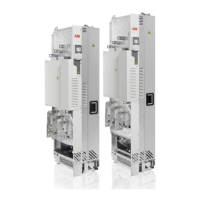l (m)
du/dt
------------
1.0
2.0
5.0
4.0
3.0
1.5
2.5
3.5
4.5
100 200 300
5.5
(1/µs)
U
n
Û
LL
/U
n
100 200 300
0.0
0.5
1.0
1.5
2.0
2.5
3.0
l (m)
du/dt
U
n
------------
Û
LL
/U
n
(1/µs)
Drive without d
u
/d
t
filterDrive with d
u
/d
t
filter
Motor cable length
I
Relative peak line-to-line voltage
Û
LL
/
U
n
Relative d
u
/d
t
value(d
u
/d
t
)/
U
n
Note:
Û
LL
and d
u
/d
t
values are approximately 20% higher during the resistor braking.
Additional note for sine filters
A sine filter also protects the motor insulation system. The peak phase-to-phase
voltage with a sine filter is approximately 1.5 ·
U
n
.
Selecting the power cables
■ General guidelines
Select the input power and motor cables according to local regulations.
• Current: Select a cable capable of carrying the maximum load current and suitable
for the prospective short-circuit current provided by the supply network. The
method of installation and ambient temperature affect the cable current carrying
capacity. Obey local regulations and laws.
• Temperature: For an IEC installation, select a cable rated for at least 70 °C (158 °F)
maximum permissible temperature of conductor in continuous use.
For North America, select a cable rated for at least 75 °C (167 °F).
Important: For certain product types or option configurations higher temperature
rating may be required. See the technical data for details.
• Voltage: 600 V AC cable is accepted for up to 500 V AC. 750 V AC cable is accepted
for up to 600 V AC. 1000 V AC cable is accepted for up to 690 V AC.
To comply with the EMC requirements of the CE mark, use one of the preferred cable
types. See Preferred power cable types (page 83).
Symmetrical shielded cable reduces electromagnetic emission of the whole drive
system as well as the stress on motor insulation, bearing currents and wear.
Metal conduit reduces electromagnetic emission of the whole drive system.
■ Typical power cable sizes
See the technical data.
82 Guidelines for planning the electrical installation

